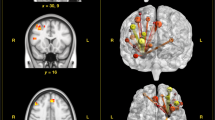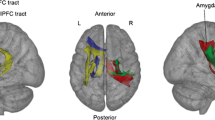Abstract
Ambiguity tolerance (AT) is the way one perceives and processes ambiguous environmental stimulus information. By using resting-state functional magnetic resonance imaging (fMRI) and the Multiple Stimulus Types Ambiguity Tolerance Scale-II (MSTAT-II), the present study investigated the association between AT and functional connectivity of the brain in 315 healthy young participants. Based on previous studies, the middle temporal gyrus (MTG), inferior parietal lobe (IPL), orbitofrontal gyrus (OFC), middle frontal gyrus (MFG), anterior insula (AI), anterior cingulate cortex (ACC) and amygdala were selected as the seed regions. We investigated the association between whole-brain functional connectivity and AT scores. The results showed a significant positive correlation between the AT scores and functional connectivity between the left IPL and middle cingulate cortex (MCC), left MFG, and left MTG, reflecting the neural basis of AT, which represents how people perceive ambiguous stimuli and assess possible risks underlying ambiguity. And the OFC was found a negative correlation between the AT scores and functional connectivity between the ACC, which revealed the underlying mechanism of ambiguity intolerance.


Similar content being viewed by others
Data Availability
The data that support the findings of this study are available from [Southwest University Longitudinal Imaging Multimodal (SLIM) Brain Data Repository: A Long-term Test-Retest Sample of YoungHealthy Adults in Southwest China], but restrictions apply to the availability of these data, which were used under licence for the current study, and so are not publicly available. Data are however available from the authors upon reasonable request and with permission of SLIM Brain Data Repository.
Please refer to the website link below for more details: http://fcon_1000.projects.nitrc.org/indi/retro/southwestuni_qiu_index.html.
References
Ashburner, J., & Friston, K. J. (2005). Unified segmentation. Neuroimage, 26, 839–851. https://doi.org/10.1016/j.neuroimage.2005.02.0
Bambini, V., Gentili, C., Ricciardi, E., Bertinetto, P. M., & Pietrini, P. (2011). Decomposing metaphor processing at the cognitive and neural level through functional magnetic resonance imaging. Brain Research Bulletin. https://doi.org/10.1016/j.brainresbull.2011.07.015
Binder, J. R., Desai, R. H., Graves, W. W., & Conant, L. L. (2009). Where is the semantic system? A critical review and meta-analysis of 120 functional neuroimaging studies. Cerebral Cortex. https://doi.org/10.1093/cercor/bhp055
Bors, D. A., Gruman, J. A., & Shukla, S. (2010). Measuring tolerance of ambiguity: Item polarity, dimensionality, and criterion validity. Revue Europeenne de Psychologie Appliquee. https://doi.org/10.1016/j.erap.2010.07.001
Brass, M., & Von Cramon, D. Y. (2004). Selection for cognitive control: A functional magnetic resonance imaging study on the selection of task-relevant information. The Journal of Neuroscience. https://doi.org/10.1523/JNEUROSCI.2513-04.2004
Brass, M., Schmitt, R. M., Spengler, S., & Gergely, G. (2007). Investigating action understanding: Inferential processes versus action simulation. Current Biology. https://doi.org/10.1016/j.cub.2007.11.057
Dickhaut, J., McCabe, K., Nagode, J. C., Rustichini, A., Smith, K., & Pardo, J. V. (2003). The impact of the certainty context on the process of choice. Proceedings of the National Academy of Sciences, 100(6), 3536–3541. https://doi.org/10.1073/pnas.0530279100
Drummond, G. B. (1990). Declaration of Helsinki. Anaesthesia, 45(1), 59–59.
Fox, M. D., Snyder, A. Z., Vincent, J. L., Corbetta, M., Van Essen, D. C., & Raichle, M. E. (2005). From the cover: The human brain is intrinsically organized into dynamic, anticorrelated functional networks. Proceedings of the National Academy of Sciences, 102(27), 9673–9678. https://doi.org/10.1073/pnas.0504136102
Fox, M. D., Snyder, A. Z., Vincent, J. L., & Raichle, M. E. (2007). Intrinsic fluctuations within cortical systems account for Intertrial variability in human behavior. Neuron. https://doi.org/10.1016/j.neuron.2007.08.023
Friston, K. J., Williams, S., Howard, R., Frackowiak, R. S. J., & Turner, R. (1996). Movement-related effects in fMRI time-series. Magnetic Resonance in Medicine, 35(3), 346–355. https://doi.org/10.1002/mrm.1910350312
Fullana, M. A., Harrison, B. J., Soriano-Mas, C., Vervliet, B., Cardoner, N., Àvila-Parcet, A., & Radua, J. (2016). Neural signatures of human fear conditioning: An updated and extended meta-analysis of fMRI studies. Molecular Psychiatry. https://doi.org/10.1038/mp.2015.88
Furnham, A. (1994). A content, correlational and factor analytic study of four tolerance of ambiguity questionnaires. Personality and Individual Differences. https://doi.org/10.1016/0191-8869(94)90066-3
Furnham, A., & Marks, J. (2013). Tolerance of ambiguity: A review of the recent literature. Psychology. https://doi.org/10.4236/psych.2013.49102
Gennari, S. P., MacDonald, M. C., Postle, B. R., & Seidenberg, M. S. (2007). Context-dependent interpretation of words: Evidence for interactive neural processes. NeuroImage. https://doi.org/10.1016/j.neuroimage.2007.01.015
Grenier, S., Barrette, A. M., & Ladouceur, R. (2005). Intolerance of uncertainty and intolerance of ambiguity: Similarities and differences. Personality and Individual Differences. https://doi.org/10.1016/j.paid.2005.02.014
Haier, R. J., & Jung, R. E. (2007). Beautiful minds (i.e., brains) and the neural basis of intelligence. Behavioral and Brain Sciences. https://doi.org/10.1017/S0140525X07001380
Henson, R. K. (2001). Understanding internal consistency reliability estimates: A conceptual primer on coefficient alpha. Measurement and Evaluation in Counseling and Development. https://doi.org/10.1080/07481756.2002.12069034
Jenkinson, M., Bannister, P., Brady, M., & Smith, S. (2002). Improved optimization for the robust and accurate linear registration and motion correction of brain images. NeuroImage, 17(2), 825–841. https://doi.org/10.1006/nimg.2002.1132
Ketteler, D., Kastrau, F., Vohn, R., & Huber, W. (2008). The subcortical role of language processing. High level linguistic features such as ambiguity-resolution and the human brain; an fMRI study. NeuroImage. https://doi.org/10.1016/j.neuroimage.2007.10.023
Lauro, L. J. R., Tettamanti, M., Cappa, S. F., & Papagno, C. (2008). Idiom comprehension: A prefrontal task? Cerebral Cortex. https://doi.org/10.1093/cercor/bhm042
Li, W., Yang, W., Li, W., Li, Y., Wei, D., Li, H., Qiu, J., & Zhang, Q. (2015). Brain structure and resting-state functional connectivity in university professors with high academic achievement. Creativity Research Journal. https://doi.org/10.1080/10400419.2015.1030311
Lieberman, M. D., Berkman, E. T., & Wager, T. D. (2009). Correlations in social neuroscience Aren’t voodoo: Commentary on Vul et al. (2009). Perspectives on Psychological Science. https://doi.org/10.1111/j.1745-6924.2009.01128.x
Liu, D., Chen, Q., Shi, B., & Qiu, J. (2019). The brain mechanism of mind popping based on resting-state functional connectivity. NeuroReport. https://doi.org/10.1097/WNR.0000000000001286
McLain, D. L. (2009). Evidence of the properties of an ambiguity tolerance measure: The multiple stimulus types ambiguity tolerance scale-ii (mstat-ii). Psychological Reports. https://doi.org/10.2466/PR0.105.3.975-988
Miller, M. B., Valsangkar-Smyth, M., Newman, S., Dumont, H., & Wolford, G. (2005). Brain activations associated with probability matching. Neuropsychologia, 43(11), 1598–1608. https://doi.org/10.1016/j.neuropsychologia.2005.01.021
Mollo, G., Jefferies, E., Cornelissen, P., & Gennari, S. P. (2018). Context-dependent lexical ambiguity resolution: MEG evidence for the time-course of activity in left inferior frontal gyrus and posterior middle temporal gyrus. Brain and Language. https://doi.org/10.1016/j.bandl.2018.01.001
Morriss, J., Gell, M., & van Reekum, C. M. (2019). The uncertain brain: A co-ordinate based meta-analysis of the neural signatures supporting uncertainty during different contexts. Neuroscience and Biobehavioral Reviews. https://doi.org/10.1016/j.neubiorev.2018.12.013
Noonan, K. A., Jefferies, E., Visser, M., & Lambon Ralph, M. A. (2013). Going beyond inferior prefrontal involvement in semantic control: Evidence for the additional contribution of dorsal angular gyrus and posterior middle temporal cortex. Journal of Cognitive Neuroscience. https://doi.org/10.1162/jocn_a_00442
Piazza, M., & Dehaene, S. (2004). From number neurons to mental arithmetic: The cognitive neuroscience of number sense. The Cognitive Neurosciences 3rd Edition Ed MS Gazzaniga. https://doi.org/10.1.1.10.5117.
Poldrack, R. A., & Mumford, J. A. (2009). Independence in ROI analysis: Where is the voodoo? Social Cognitive and Affective Neuroscience. https://doi.org/10.1093/scan/nsp011
Power, J. D., Cohen, A. L., Nelson, S. M., Wig, G. S., Barnes, K. A., Church, J. A., … Petersen, S. E. (2011). Functional network Organization of the Human Brain. Neuron, 72(4), 665–678. https://doi.org/10.1016/j.neuron.2011.09
Power, J. D., Lynch, C. J., Adeyemo, B., & Petersen, S. E. (2020). A critical, event-related appraisal of Denoising in resting-state fMRI studies. Cerebral Cortex. https://doi.org/10.1093/cercor/bhaa139
Pushkarskaya, H., Liu, X., Smithson, M., & Joseph, J. E. (2010). Beyond risk and ambiguity: Deciding under ignorance. Cognitive, Affective, & Behavioral Neuroscience. https://doi.org/10.3758/CABN.10.3.382
Raven, J., Raven, J. C., & Court, J. H. (1998). Manual for Raven’s progressive matrices and vocabulary scales. Section 4: The Advanced Progressive Matrices. Harcourt Assessment.
Rodd, J. M., Davis, M. H., & Johnsrude, I. S. (2005). The neural mechanisms of speech comprehension: fMRI studies of semantic ambiguity. Cerebral Cortex. https://doi.org/10.1093/cercor/bhi009
Rolls, E. T., Cheng, W., Du, J., Wei, D., Qiu, J., Dai, D., Zhou, Q., Xie, P., & Feng, J. (2020). Functional connectivity of the right inferior frontal gyrus and orbitofrontal cortex in depression. Social Cognitive and Affective Neuroscience. https://doi.org/10.1093/scan/nsaa014
Rushworth, M. F. S., & Behrens, T. E. J. (2008). Choice, uncertainty and value in prefrontal and cingulate cortex. Nature Neuroscience. https://doi.org/10.1038/nn2066
Saxe, R., Carey, S., & Kanwisher, N. (2004). Understanding other minds: Linking Developmental Psychology and functional neuroimaging. Annual Review of Psychology. https://doi.org/10.1146/annurev.psych.55.090902.142044
Shackman, A. J., & Fox, A. S. (2016). Contributions of the central extended amygdala to fear and anxiety. The Journal of Neuroscience. https://doi.org/10.1523/JNEUROSCI.0982-16.2016
Smithson, M., Bartos, T., & Takemura, K. (2000). Human judgment under sample space ignorance. Risk, Decision and Policy. https://doi.org/10.1017/S1357530900000144
Takeuchi, H., Sekiguchi, A., Taki, Y., Yokoyama, S., Yomogida, Y., Komuro, N., Yamanouchi, T., Suzuki, S., & Kawashima, R. (2010). Training of working memory impacts structural connectivity. The Journal of Neuroscience. https://doi.org/10.1523/JNEUROSCI.4611-09.2010
Vickery, T. J., & Jiang, Y. V. (2008). Inferior parietal lobule supports decision making under uncertainty in humans. Cerebral Cortex, 19(4), 916–925. https://doi.org/10.1093/cercor/bhn140
Vul, E., Harris, C., Winkielman, P., & Pashler, H. (2009). Puzzlingly high correlations in fMRI studies of emotion, personality, and social Cognition1. Perspectives on Psychological Science. https://doi.org/10.1111/j.1745-6924.2009.01125.x
Ward, B.D. (2000). Simultaneous inference for fMRI data. AFNI 3d Deconvolve documentation. Medical College of Wisconsin [cited; Available from: http://afni.nimh.nih.gov/pub/dist/doc/manual/AlphaSim.pdf. Accessed Jan 2021.
Yan, C.-G., Cheung, B., Kelly, C., Colcombe, S., Craddock, R. C., Di Martino, A., … Milham, M. P. (2013). A comprehensive assessment of regional variation in the impact of head micromovements on functional connectomics. NeuroImage, 76, 183–201. https://doi.org/10.1016/j.neuroimage.2013.03.004
Zhuang, K., Yang, W., Li, Y., Zhang, J., Chen, Q., Meng, J., … Qiu, J. (2020). Connectome-based evidence for creative thinking as an emergent property of ordinary cognitive operations. NeuroImage, 117632. https://doi.org/10.1016/j.neuroimage.2020.117632
Funding
This research was supported by the National Natural Science Foundation of China (32071080; 31571138; 31470981; 31571137; 31500885; 31600878; 31771231), Project of the National Defense Science and Technology Innovation Special Zone, Chang Jiang Scholars Program, National Outstanding Young People Plan, the Program for the Top Young Talents by Chongqing, the Fundamental Research Funds for the Central Universities (SWU1609177), Natural Science Foundation of Chongqing (cstc2015jcyjA10106), Fok Ying Tung Education Foundation (151023), the Research Program Funds of the Collaborative Innovation Center of Assessment toward Basic Education Quality at Beijing Normal University.
Author information
Authors and Affiliations
Corresponding authors
Ethics declarations
Conflict of Interests
The authors declare that they have no conflicts of interest.
Additional information
Publisher’s note
Springer Nature remains neutral with regard to jurisdictional claims in published maps and institutional affiliations.
Rights and permissions
About this article
Cite this article
Liu, D., Sun, J., Ren, Z. et al. The neural basis of acceptance of uncertain situations: Relationship between ambiguity tolerance and the resting-state functional connectivity of the brain. Curr Psychol 42, 17033–17041 (2023). https://doi.org/10.1007/s12144-022-02879-5
Accepted:
Published:
Issue Date:
DOI: https://doi.org/10.1007/s12144-022-02879-5




